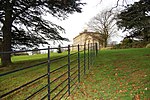Sprotbrough
Use British English from September 2020Villages in Doncaster

Sprotbrough is a village in the City of Doncaster in South Yorkshire, England, with a population of 7,548 at the 2021 census. The village is transected by the A1(M) motorway and is situated at the top of the Don Gorge, some 3 miles (4.8 km) west of Doncaster city centre. With Cusworth to the north, it forms the civil parish of Sprotbrough and Cusworth, which had a population of 12,134 in 2011.The electoral ward of Sprotbrough, including numerous rural villages to the north and west, had a population of 11,143.
Excerpt from the Wikipedia article Sprotbrough (License: CC BY-SA 3.0, Authors, Images).Sprotbrough
Main Street, Doncaster Sprotbrough and Cusworth
Geographical coordinates (GPS) Address Nearby Places Show on map
Geographical coordinates (GPS)
| Latitude | Longitude |
|---|---|
| N 53.5119763 ° | E -1.1881056 ° |
Address
Main Street
DN5 7RF Doncaster, Sprotbrough and Cusworth
England, United Kingdom
Open on Google Maps










